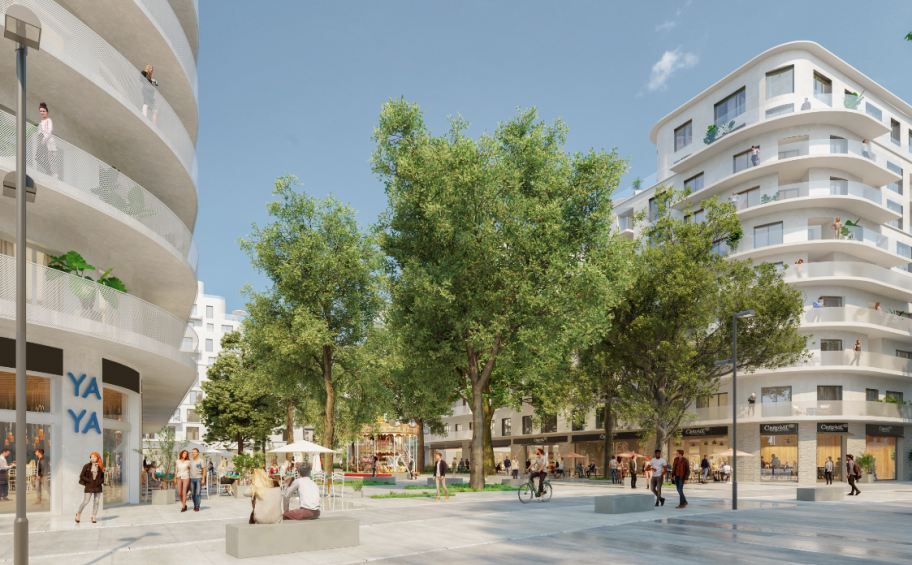2,153 housing units (including 1,803 in France) were ordered from Eiffage Immobilier, up 11% against 2023. 52% (1,127 units) of these orders were bulk sales to institutional investors and social housing providers, up 18% against 2023.
Eiffage Immobilier launched 37 housing programmes representing a marketing potential of 2,413 housing units.
Eiffage Aménagement, a key urban planning stakeholder, has 760,000 m² under construction and 430,000 m² in the planning and development phase.
2024 highlights
- Inauguration of Place Simone Veil in the heart of the Lizé eco-district in Montigny-lès-Metz (57).
- Deliveries of housing units for the Athletes' Village in Saint-Ouen (93) to the Paris Organising Committee.
- Delivery of 237 housing units of the first work package of the LaVallée SEMOP (single-operation semi-public company) in Châtenay-Malabry (92).
- Delivery of Eiffage Construction's new Ile-de-France regional offices, a former Ricqlès mint alcohol distillery, in Saint-Ouen (93).
- Delivery of a new building under the 'Archipel' commercial real estate programme in Bordeaux (33).
- Eiffage Aménagement and the Launay Group won the concession for the multi-site urban development zone in Saint-Grégoire (35), the first SEMOP (single-operation semi-public company) in France created for a multi-site urban planning project.
- Launch of the first real estate projects in Saint-Apollinaire (21) at Les Longènes business park, dedicated to healthcare.
Anticipating Shifting Needs and Tomorrow’s Ways of living
'Our business is changing — whether in property development or urban planning —. While we continue our core mission of reshaping the city from within, we are increasingly faced with longer and more complex projects. Today’s urban developers must adapt to stricter environmental requirements, integrate new uses, reinvent living spaces, and above all, produce affordable housing', said Luc Bouvet, Managing Director of Eiffage Immobilier.
Sociodemographic changes with Cocoon'Ages® and Cazam®
Cocoon'Ages® intergenerational residences continued its development with a new delivery in Pornic (44), bringing the total number of residences delivered to 21. Three new projects are in the planning and development phase, and work on a new residence in Saint-Gaudens (31) has started.
Regarding Cazam® senior residences, four new residences have been opened under the Eiffage Immobilier and Montana partnership. With these new residences, Cazam@ has an offering of over 1,000 housing units in France. Around fifteen Cazam® residences are currently in the planning and development phase.
Evolving Uses and the Rise of Rehabilitation Projects
One key example is the renewal of Batignolles, a historically industrial district in Nantes (44), which includes the construction of six commercial and office buildings, along with the rehabilitation of an industrial hall, all within the framework of a new urban development plan
Another noteworthy project is the conversion of the former Benauge fire station in Bordeaux (33) which combines rehabilitation with new construction. This project is characterised by its first phase of temporary occupancy implemented in 2024, ahead of construction beginning in late 2025 and the projected delivery of the completed programs in 2028:
- The Eiffage Immobilier and Eiffage Construction teams moved into the old fire station's offices.
- 20 solidarity housing units were provided by a social landlord and a homeless shelter was opened with the Diaconat association.
- The gym is open to the neighbourhood's associations and features a pop-up skatepark.
- The large fire station garage and courtyard have been temporarily converted into a lively space featuring a pop-up bar and restaurant and an open stage offer.
The need to build differently:
Eiffage Immobilier’s off-site business, drawing on the expertise of Savare (wood builder), B3 Ecodesign (builder of modular buildings using maritime containers) and HVA Concept (builder of industrialised bathrooms), is experiencing strong growth. Several projects are underway, including a 3-star hotel with 80 rooms, a project involving around 500 housing units, and a commercial real estate project in Île-de-France.
In Normandy and Brittany, Eiffage Immobilier is developing a scalable housing programme, designed to adapt to residents’ needs. Thanks to an innovative modular design, housing can be expanded or reduced without the need for structural work. This construction principle, based on a wooden structure and prefabricated facades (wood framed facades), optimises the building's life cycle, in line with circular economy principles. No requiring formwork, this project aims to be reproducible, affordable, and scalable. It also supports the sector’s environmental ambitions by targeting the RE2028 thresholds.
Strong growth in Europe
The subsidiary’s real estate business in Poland is continuing to grow with five construction projects totalling some 1,050 housing units underway. The 146 Marcelinska housing units in Poznań were delivered. Eiffage Immobilier Polska bulk sold the 185 housing units and 3 business units of Białostocka 5D in Warsaw.
The Swiss subsidiary is developing its first retail housing project, Naters-Tschill. Work is scheduled to start in Q2 2025.
Outlook for 2025
The year 2025 begins with promising prospects. Work continues on the development of several eco-districts in Dijon (Côte-d'Or), Igny (Essonne), Montigny-lès-Metz, and Châtenay-Malabry. In L’Haÿ-les-Roses (Val-de-Marne), the first housing units are under construction within the Lallier development zone, a regeneration project located at the foot of a new station on metro line 14. Additionally, the land acquisition for the six-hectare Cathédrales du Rail site in Saint-Denis (Seine-Saint-Denis) has been finalized, marking a key milestone in the project's advancement. Lastly, the so-called "legacy" phase of the Athletes' Village—comprising 527 housing units—has officially been launched.
Eiffage Immobilier is also exploring several housing projects to support the EPR2 nuclear reactor initiative in Penly (Seine-Maritime). The goal is twofold: to quickly and efficiently meet the housing needs of the workforce involved in the project, and to propose modular, reusable housing solutions that avoid long-term land artificialization.

